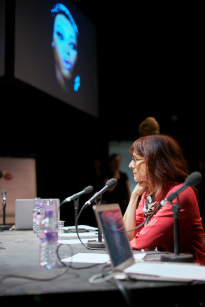My European travels this summer included the performance festival organized by Arika in Glasgow. Billed as an “episode” called Hidden in Plain Sight and devoted to queer culture, it followed on an earlier episode (prominently featuring Fred Moten) called Freedom is a Constant Struggle and spearheaded by the sound collective Ultra-red, which has staged a series of events (including a related program at last year’s Whitney Biennial) to explore embodied and creative practices of freedom.

I was intrigued by the programming, especially the presentation of scholars alongside artists, and also by the genre of the episode as a way to create new kinds of public forums that include conversation. And the results were spectacular and moving. I did not expect to go all the way to Glasgow to learn about voguing! But Robert Sember of Ultra-red and Michael Roberson, who is a veteran of the Harlem ballroom scene and a student of theology, have been collaborating on Vogue-ology, an informal school of theory and practice dedicated to preserving and circulating knowledge of the ballroom scene. I was invited to participate on a panel in which we watched archival video clips and responded to Roberson’s questions -- what did you see?; what did you hear?; and what did you feel?” -- ideal prompts for my public feelings sensibility. It released a flood of memories from the emotional time capsule of the late 1980s moment of Madonna and Paris Is Burning, both of which were central to my experience of queer theory’s explosion. Voguing was about the nexus of subculture and mass culture, crossings of race, class, and gender in capitalist economies, embodied epistemologies of the dance floor, and much more. I was delighted to see Vogue-ology keeping voguing’s place in the queer archive very much alive.

Another of many revelatory performances was that of Trajal Harrell, who has choreographed a series of dances based on the premise of the Harlem ballroom scene coming downtown to meet the Judson Theatre postmodern dance scene in the 1960s. He did a solo show, as well as a virtuoso ensemble performance with a group of queer European dancers of various genders. There were also a number of dyke artists in the mix: Pauline Boudry and Renate Lorenz, with whom I’ve been collaborating of late, screened their films; Antonia Baehr, who stars in many of their films as Werner Hirsch did a solo performance about dog-human relations; the artist Emma Hedditch came as a fellow traveler participant; and Jack Halberstam presented his latest work on anarchy and wildness. I gave a public lecture about my book in which I emphasize the importance of curating spaces (such as Sheila Pepe’s Common Sense) for new kinds of feelings and sensations and also facilitated a workshop discussion about queer archives. I loved putting my professor knowledge to work in a creative context and seeing new possibilities for how to perform and curate conversations about ideas and feelings.


 RSS Feed
RSS Feed